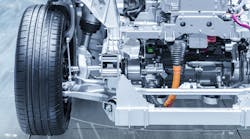EV Spotlight Shifting to Hybrid Drivetrains
What you’ll learn:
- Why hybrid drivetrains are important.
- Why series and parallel drivetrains may be a viable solution.
- How companies are working to bring about smart solutions for clean engines.
Environment-friendly technologies have forayed into the automotive industry in a bid to curb emissions as power-integration-mechanism (PIM) design continues to boost the hybrid drivetrain portfolio. Assessing the cost-benefit analysis, hybrid vehicles have become key players in the quest to reduce fuel consumption. With efficiency enhancement becoming more important than ever, automakers are focusing on enhancing engine power and the electric motor, reducing cost, and bolstering consumer features.
With the ongoing issue of a dearth of charging infrastructure for electric vehicles (EVs), hybrid vehicles are becoming a cornerstone of future mobility. Boosting powertrain efficiency and reducing powertrain weight are keys to streamlining the hybrid drivetrain.
What’s been so compelling is the use of green electrical energy in the manufacturing of hybrid powertrains with zero-emission driving capability. In turn, forward-looking companies are boosting powertrain efficiency, vehicle functionalities, and reducing cost premium for the hybrid powertrains.
And, of course, hybrid electric vehicles have come up as one of the most sought-after solutions to achieve superior mileage, reduce emissions, and reduce fuel consumption as compared to traditional internal-combustion-engine (ICE)-based vehicles.
HEVs tend to be composed of an ICE with one or more electric motors. Notably, three drivetrain architectures—series, parallel, and series-parallel—have been the major focus of end markets.
The architecture of electromechanical power-coupling system has emerged as one of the most pivotal technologies for HEVs. The power-coupling mode of the various structures decides the operating mode of the hybrid powertrain systems and becomes the basis of formulating the power-distribution strategy.
Why Hybrid Drivetrains?
When it comes to overall energy efficiency, hybrid drivetrains hold an edge over the conventional vehicle. For instance, hybrid drivetrains can do away with some of the energy losses linked with engine operation at load and speed combinations.
Hybrid drivetrains have the ability to capture some of the energy usually lost as heat to the mechanical brakes. Moreover, an HEV’s ICE is downsized because the storage device tends to take up a part of the load.
The “Who’s Who” of the automotive industry, including General Motors, Hyundai, Nissan, BMW, Mercedes, Audi, and Porsche, have rolled out variants of single-motor, twin clutch hybrid systems, among others.
Penetration of the hybrid drivetrain industry has been marred somewhat by fuel-efficient diesel engines. That said, hybrid drivetrains can reduce fuel consumption and CO2 emissions by up to 35%. Notable upsides of using hybrid drivetrain are the productivity gains and less maintenance.
An upsurge in demand for less-costly machines has construction equipment manufacturers looking into hybrid drives. With hybrid drives, OEMs can operate at speeds where the machines run cleanest, are most efficient, and use smaller diesel engines. The drives are able to reuse and recover energy that was wasted as heat.
Series/Parallel Drivetrains
Hybrids that prefer series drivetrains receive mechanical power from the electric motor, run either by a gasoline-powered generator or a battery. Series drivetrains leverage the electric motor and engine to deliver the power together or independently.
Series drivetrains are popular as range-extended electric vehicles (REEVs) or extended-range electric vehicles (EERVs), given that the gas engine never directly drives the wheels and merely generates electricity to be used by the electric motor. They tend to perform well at the time of stop-and-go traffic, wherein diesel engines and gasoline are efficient. The engine tends to be smaller in a series drivetrain, as it needs to keep up with the power demands.
Of late, parallel drivetrains are gaining traction—they often use a smaller battery pack than series drivetrains, counting on regenerative braking to keep it recharged. In addition, parallel hybrids use the motor as a generator for supplemental recharging when power demands are low.
One of the major upsides of parallel drivetrain is that it eliminates the inefficiency of converting mechanical power to electricity and back, thus boosting the efficiency of hybrids.
Series/parallel drivetrains have become more popular among OEMs because the engine can be disconnected, with merely the electric motor providing power. At high speeds, the engine takes over and energy loss is reduced; it operates more as a series vehicle at lower speeds. One factor to keep in mind: While series/parallel drivetrains will deliver better performance and fuel efficiency versus parallel or series drivetrains, the system can incur higher costs than a parallel hybrid.
What’s Happening Now
Smart solutions pertaining to clean engines, electrification, and automated transmissions for vehicles will likely boost the hybrid drivetrain market forecast. For instance, General Motors and Honda joined forces to develop two new EVs earlier this year. Honda also invested in Cruise, GM’s majority-owned autonomous vehicles. Reportedly, the two companies would develop a purpose-built electric autonomous vehicle.
Audi, providing an overview of its four distinct EV platforms, is gearing to up have 30 electrified models come onto the market, with 20 of the vehicles fully electric. Audi has already rolled out five production models in the U.S. The Audi e-tron SUV, the first all-electric SUV, uses a range of EV drivetrain technology.
Sunil Kumar Jha is a Content Writer for Global Market Insights Inc.
